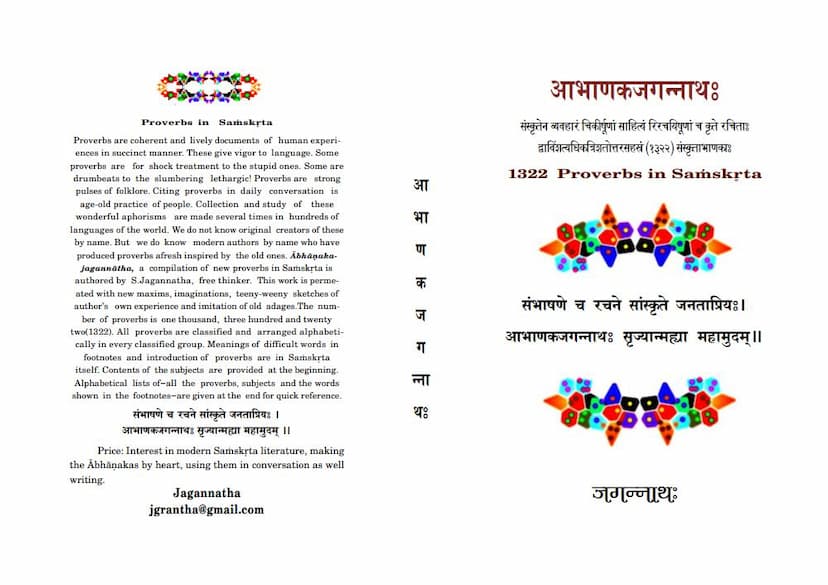Abhanakajagannatha
Added to library: September 1, 2025

Summary
Here's a comprehensive summary of the Jain text "Abhanakajagannatha," based on the provided pages:
Title: Abhanakajagannatha Author: S. Jagannatha, a free thinker. Publisher: Jagannath Ambaram
Overview:
"Abhanakajagannatha" is a collection of 1,322 new proverbs (ābhāṇakas) composed in Sanskrit. The work aims to enrich the Sanskrit language and facilitate its use in conversation and writing for modern Sanskrit enthusiasts.
Nature of Ābhāṇakas (Proverbs):
The text begins by defining proverbs as concise, vibrant expressions of human experience that invigorate language. They can serve as a "shock treatment" for the foolish or a call to action for the lethargic. The author distinguishes ābhāṇakas from lokokti (idioms) and subhāṣitas (well-said sayings/aphorisms).
- Ābhāṇakas vs. Lokokti: While lokokti are often recognized for their idiomatic usage where the meaning is established by convention rather than literal interpretation (e.g., "closing eyes and signing"), the author sees ābhāṇakas as a broader category.
- Ābhāṇakas vs. Subhāṣitas: Subhāṣitas primarily aim to convey well-thought-out ideas, often with examples or explanations. Ābhāṇakas, on the other hand, are described as having "word-set strength" (padlasmudaśaktimatī). They offer a "crooked glance" (vakrayā dṛśā) at society and life, unlike subhāṣitas which provide a "straight glance" (ṛjyā dṛṣṭyā).
- Emotional Tone: Subhāṣitas are characterized by their affectionate and nurturing tone, like a mother's touch. Ābhāṇakas, however, can be sharp and admonishing, like a whip striking a dream.
- Content and Impact: Ābhāṇakas are seen as reflecting the earthy realities of life, both the pleasant ("ocean of milk") and the unpleasant ("muddy stream"). They can be both instructive and shocking. While subhāṣitas often focus on peace (śāntirasa), ābhāṇakas can encompass humor, valor, and anger (hāsyavīraradrarasa). They are considered the "jesters" in the "royal court" of subhāṣitas.
The Author's Approach and the Work's Structure:
- Inspiration and Originality: Jagannatha acknowledges that proverbs often lack named original creators, but he has produced these anew, inspired by older adages and his own experiences and imaginations.
- Classification and Arrangement: The 1,322 proverbs are classified and arranged alphabetically within each category.
- Difficult Words: Meanings of difficult words are provided in footnotes, and introductions are also in Sanskrit.
- Referencing: Contents are listed at the beginning, and alphabetical indexes of proverbs, subjects, and footnote words are provided at the end for quick reference.
- Scope: The work primarily focuses on proverbs (ābhāṇakas) and vākūḍhyāḥ (lokoktayaḥ or proverbs) and subhāṣitas. Riddles (prahelikā) are excluded as they fall outside the scope of this particular compilation.
- Author's Intent: The author aims to make the proverbs memorable, usable in daily conversation, and influential for modern Sanskrit literature. He views the creation of proverbs as a challenging process, akin to the "labor pain of birth."
- Evolution of the Work: The book has gone through several editions:
- First appeared in the Sanskrit journal Sudharma in 1982.
- First printed edition as a book in 2005.
- Second revised edition in 2007.
- Third revised edition in 2009, which is the current edition being promoted. Each subsequent edition has added more proverbs.
- Inclusion of Vedic Terms: The author notes the increasing use of Vedic terms in his work, drawing parallels to classical Sanskrit poets who incorporated Vedic language. He has consulted various scholarly works for the meanings and usage of these terms.
- Usage of Proverbs: Proverbs are categorized based on various themes, including life lessons, human behaviors, social interactions, relationships, moral conduct, and even specific subjects like Ramayana and Mahabharata.
Key Themes and Distinctions:
The text highlights the diverse nature of proverbs and their role in reflecting life's complexities. It touches upon the following:
- Critique of Existing "Subhāṣitas": The author expresses concern about certain collections of "subhāṣitas" that may contain vulgarity, lack social utility, or promote foolishness, particularly those that seem to devalue women.
- The Nature of Truth and Wisdom: The book implicitly questions the uncritical acceptance of all proverbs, suggesting that some might be flawed ("unripe wisdom") or even detrimental.
- The Power of Language: The author emphasizes the effectiveness of proverbs in conveying messages, whether through subtle implications or direct pronouncements.
- The Role of Ābhāṇakas: They are presented as a vital tool for understanding and navigating life, offering insights into human nature and societal dynamics.
Copyright and Usage:
The author grants permission for the work to be used for academic purposes (paper presentations, PhDs) with proper acknowledgment. However, translation of the entire work into any language is prohibited, as the author plans to translate it into English himself.
In essence, "Abhanakajagannatha" is a significant contribution to modern Sanskrit literature, offering a vast repository of original proverbs designed to capture the nuances of human life and language, presented with scholarly rigor and a deep appreciation for the Sanskrit tradition.